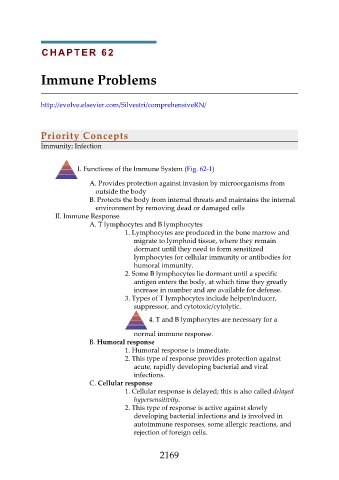Page 2169 - Saunders Comprehensive Review For NCLEX-RN
P. 2169
CHAPTER 62
Immune Problems
http://evolve.elsevier.com/Silvestri/comprehensiveRN/
Priority Concepts
Immunity; Infection
I. Functions of the Immune System (Fig. 62-1)
A. Provides protection against invasion by microorganisms from
outside the body
B. Protects the body from internal threats and maintains the internal
environment by removing dead or damaged cells
II. Immune Response
A. T lymphocytes and B lymphocytes
1. Lymphocytes are produced in the bone marrow and
migrate to lymphoid tissue, where they remain
dormant until they need to form sensitized
lymphocytes for cellular immunity or antibodies for
humoral immunity.
2. Some B lymphocytes lie dormant until a specific
antigen enters the body, at which time they greatly
increase in number and are available for defense.
3. Types of T lymphocytes include helper/inducer,
suppressor, and cytotoxic/cytolytic.
4. T and B lymphocytes are necessary for a
normal immune response.
B. Humoral response
1. Humoral response is immediate.
2. This type of response provides protection against
acute, rapidly developing bacterial and viral
infections.
C. Cellular response
1. Cellular response is delayed; this is also called delayed
hypersensitivity.
2. This type of response is active against slowly
developing bacterial infections and is involved in
autoimmune responses, some allergic reactions, and
rejection of foreign cells.
2169

